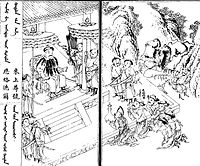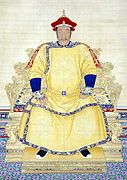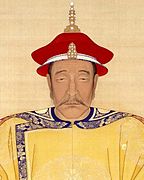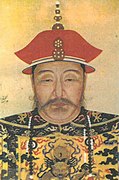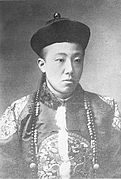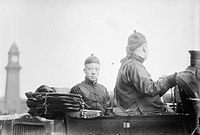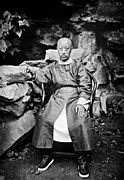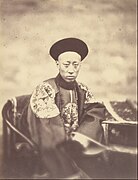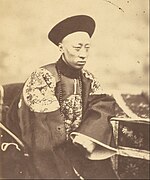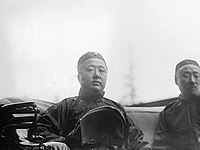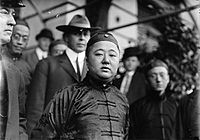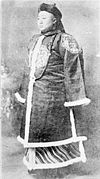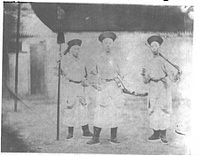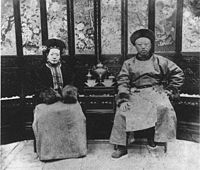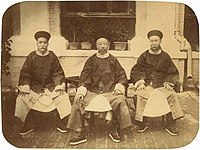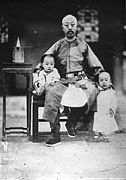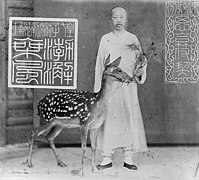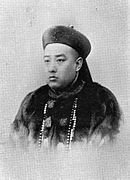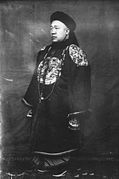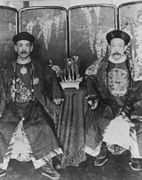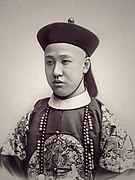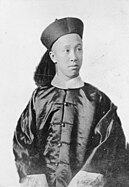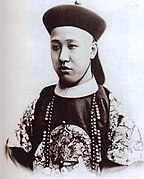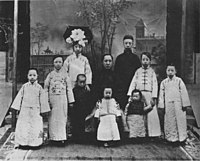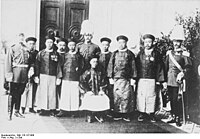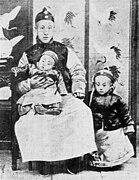House of Aisin-Gioro: Difference between revisions
Cyberbot II (talk | contribs) Rescuing 2 sources, flagging 0 as dead, and archiving 12 sources. #IABot |
|||
| Line 83: | Line 83: | ||
==Genetics== |
==Genetics== |
||
[[Haplogroup C-M217|Haplogroup C3c]] has been identified as a possible marker of the Aisin Gioro and is found in ten different ethnic minorities in northern China, but completely absent from Han Chinese.<ref>{{cite web|author= |url=http://www.ncbi.nlm.nih.gov/pmc/articles/PMC1285168/ |title=Recent Spread of a Y-Chromosomal Lineage in Northern China and Mongolia |publisher=Ncbi.nlm.nih.gov |date=2015-09-28 |accessdate=2015-11-26}}</ref><ref>[http://www.cell.com/ajhg/pdf/S0002-9297(07)63394-1.pdf ]{{dead link|date=November 2015}}</ref><ref>{{cite web|url=http://www.sciencedirect.com/science/article/pii/S0002929707633941 |title=Recent Spread of a Y-Chromosomal Lineage in Northern China and Mongolia |publisher=Sciencedirect.com |date= |accessdate=2015-11-26}}</ref><ref>[http://www.genebase.com/learning/article/23 ]{{ |
[[Haplogroup C-M217|Haplogroup C3c]] has been identified as a possible marker of the Aisin Gioro and is found in ten different ethnic minorities in northern China, but completely absent from Han Chinese.<ref>{{cite web|author= |url=http://www.ncbi.nlm.nih.gov/pmc/articles/PMC1285168/ |title=Recent Spread of a Y-Chromosomal Lineage in Northern China and Mongolia |publisher=Ncbi.nlm.nih.gov |date=2015-09-28 |accessdate=2015-11-26}}</ref><ref>[http://www.cell.com/ajhg/pdf/S0002-9297(07)63394-1.pdf ]{{dead link|date=November 2015}}</ref><ref>{{cite web|url=http://www.sciencedirect.com/science/article/pii/S0002929707633941 |title=Recent Spread of a Y-Chromosomal Lineage in Northern China and Mongolia |publisher=Sciencedirect.com |date= |accessdate=2015-11-26}}</ref><ref>[http://www.genebase.com/learning/article/23 ]{{ |date= }}</ref> |
||
==Notable Aisin-Gioros== |
==Notable Aisin-Gioros== |
||
| Line 156: | Line 156: | ||
*[[Jinliang]] (金量), fifth generation of Dao Quang, Prince Chun (醇王) of Blood (亲王) 1st rank of prince, great-grandson of Prince [[Zaitao]], and great-grandnephew of Guangxu Emperor, Xuantong (Puyi) emperor is his grand uncle |
*[[Jinliang]] (金量), fifth generation of Dao Quang, Prince Chun (醇王) of Blood (亲王) 1st rank of prince, great-grandson of Prince [[Zaitao]], and great-grandnephew of Guangxu Emperor, Xuantong (Puyi) emperor is his grand uncle |
||
*[[Jinyong]], brother of Jinliang, fifth generation of Dao Quang, 1st rank of prince, great-grandson of Prince {[Zaitao}], and great-grandnephew of Guangxu Emperor, Xuantong (Puyi) Emperor is his grand uncle |
*[[Jinyong]], brother of Jinliang, fifth generation of Dao Quang, 1st rank of prince, great-grandson of Prince {[Zaitao}], and great-grandnephew of Guangxu Emperor, Xuantong (Puyi) Emperor is his grand uncle |
||
*[[Zhao Junzhe]], [[China|Chinese]] football player<ref>[http://www.laty.gov.cn/ShowArticle.asp?ArticleID=24693 ]{{ |
*[[Zhao Junzhe]], [[China|Chinese]] football player<ref>[http://www.laty.gov.cn/ShowArticle.asp?ArticleID=24693 ]{{ |date= }}</ref> |
||
*[[King Pu-tsung]] (born 1956), a cousin of Puyi, former Secretary-General of the Kuomintang |
*[[King Pu-tsung]] (born 1956), a cousin of Puyi, former Secretary-General of the Kuomintang |
||
*[[Jin Qizong]] (Aisin-Gioro Qizong), historian and scholar of [[Manchu language]] and [[Jurchen language]] |
*[[Jin Qizong]] (Aisin-Gioro Qizong), historian and scholar of [[Manchu language]] and [[Jurchen language]] |
||
Revision as of 16:20, 6 January 2016
This article needs additional citations for verification. (November 2012) |
| Aisin Gioro Chinese: 爱新觉罗氏 Jin dynasty | |
|---|---|
| Royal house | |
 | |
| Parent house | Qing dynasty |
| Country | |
| Founded | 1616 |
| Founder | Nurhaci |
| Current head | Jin Yuzhang[1] |
| Final ruler | Puyi |
| Titles |
|
| Style(s) | "His/Her Imperial Majesty" |
| Estate(s) | Summer Palace (Beijing) Old Summer Palace (Beijing) Mukden Palace (Shenyang) Chengde Mountain Resort (Chengde) |
| Deposition | 1912 |
| House of Aisin-Gioro | |||||||
|---|---|---|---|---|---|---|---|
| Chinese name | |||||||
| Traditional Chinese | 愛新覺羅 | ||||||
| Simplified Chinese | 爱新觉罗 | ||||||
| |||||||
| Manchu name | |||||||
| Manchu script | |||||||
Aisin Gioro is the last name of a Chinese noble family and imperial clan of Manchu emperors of the Qing dynasty. The House of Aisin Gioro ruled China from 1644 until the Xinhai Revolution of 1911-12, which established a republican government in its place. The word aisin means gold in the Manchu language, and "gioro" is the name of the place in present-day Yilan, Heilongjiang Province. In Manchu custom, families are identified first by their Hala (哈拉), i.e. their family or clan name, and then by Mukūn (穆昆), the more detailed classification, typically referring to individual families. In the case of Aisin Gioro, Aisin is the Mukūn, and Gioro is the Hala. Other members of the Gioro clan include Irgen Gioro (伊尔根觉罗), Susu Gioro (舒舒觉罗) and Sirin Gioro (西林觉罗).
The Jin dynasty (jin means gold in Chinese) of the Jurchens, ancestors of the Manchus, was known as aisin gurun, and the Qing dynasty was initially named (![]() ) amaga aisin gurun, or Later Jin dynasty. Since the fall of the Empire, a number of members of the family have changed their surnames to Jin (Chinese: 金) since it has the same meaning as "Aisin". For example, Puyi's younger brother changed his name from Aisin-Gioro Puren (愛新覺羅溥任) to Jin Youzhi (金友之) and his children in turn are surnamed Jin.
) amaga aisin gurun, or Later Jin dynasty. Since the fall of the Empire, a number of members of the family have changed their surnames to Jin (Chinese: 金) since it has the same meaning as "Aisin". For example, Puyi's younger brother changed his name from Aisin-Gioro Puren (愛新覺羅溥任) to Jin Youzhi (金友之) and his children in turn are surnamed Jin.
Family generation names
Before the founding of the Qing dynasty, the naming of children in the Aisin Gioro clan was essentially arbitrary and followed no particular rules. The Manchu people originally did not use generation names before they moved into China proper; prior to the Shunzhi era, children of the imperial clan were given only a Manchu-language name, for example Dorgon.[2][3]
After taking control of China, however, the family gradually incorporated Han Chinese naming conventions.[4][5] During the reign of the Kangxi Emperor, all of Kangxi's sons were to be named with a generation prefix preceding the given name. There were three characters initially used, Cheng (承), Bao (保), and Chang (长), before finally settling on Yin (胤) over a decade into Kangxi's reign. The generation prefix of the Yongzheng Emperor's sons switched from Fu (福) to Hong (弘). Following Yongzheng, the Qianlong Emperor decreed that all subsequent male offspring would have a generation prefix placed in their name according to a Generation Poem, for which the Qianlong Emperor composed the first four characters, yong-mian-yi-zai (永綿奕載). Moreover, direct descendants of the emperor will often share a similar radical or meaning in the final character. A common radical was shared in the second character of the first name of royals who were in line to the throne, however, royals who were not in line to the throne did not necessarily share the radical in their name.[6] In one case, the Yongzheng Emperor changed the generation code of his brothers as a way of keeping his own name unique. Such practices apparently ceased to exist after the Daoguang Era.
| Order | Generation code | Radical code | Examples | |
|---|---|---|---|---|
| 1 | Yongzheng Emperor | Yin, 胤/Yun, 允 | Fortune (Shi) 示 | Yinzhi, 胤祉 |
| 2 | Qianlong Emperor | Hong, 弘 | Sun/Day (Ri) 日 | Hongzhou, 弘晝 |
| 3 | Jiaqing Emperor | Yong, 永/Yong, 顒 | Jade (Yu) 玉 | Yongqi,永琪 |
| 4 | Daoguang Emperor | Mian, 綿/Min, 旻 | Emotion (Xin) 心 | Mianyu, 綿愉 |
| 5 | Xianfeng Emperor | Yi, 奕 | Literary (Yan) 言 | Yixin, 奕訢 |
| 6 | Guangxu Emperor | Zai, 載 | Water (Shui) 水 | Zaifeng, 載灃 |
| 7 | Xuantong Emperor | Pu, 溥 | Human (Single Ren) 人 | Pujie, 溥傑 |
| 8 | Yu'e, 毓峨 | Yu, 毓 | Mountain (Shan) 山 | Yuzhan, 毓嶦 |
| 9 | Hengtai, 恒鈦 | Heng, 恒 | Metal/Gold (Jin) 金 | Hengjiang, 恒鏹 |
Subsequent: Qi 启, Dao 焘, Kai 闿, Zeng 增, Qi 祺
Foundation
The Aisin Gioro clan, as a Manchu clan, claimed descent from the Jurchen people, who founded the Jin dynasty nearly five centuries earlier under the Wanyan (完顏 Wányán) clan. However, the Aisin Gioro and Wanyan clans are unrelated.
The Aisin Gioro claimed their progenitor Bukūri Yongšon was the result of a virgin birth. According to the legend, three heavenly maidens including one named Fekulen were bathing at a lake near Changbai mountain called Bulhūri omo, when a mapgpie dropped a piece of red fruit near her and she ate it. She then became pregnant with Bukūri Yongšon.
The Aisin Gioro also claimed descent from Mentemu of the Odoli clan, who served as Chieftains of the Jianzhou Jurchens.
Under Nurhaci and his son Hong Taiji, the Aisin Gioro clan of the Jianzhou tribe won hegemony among the rival Jurchen tribes of the northeast, then through warfare and alliances extended its control into Inner Mongolia. Nurhachi created large, permanent civil-military units called “banners” to replace the small hunting groups used in his early campaigns. A banner was composed of smaller companies; it included some 7,500 warriors and their households, including slaves, under the command of a chieftain. Each banner was identified by a coloured flag that was yellow, white, blue, or red, either plain or with a border design. Originally there were four, then eight, Manchu banners; new banners were created as the Manchu conquered new regions, and eventually there were Manchu, Mongol, and Chinese banners, eight for each ethnic group. By 1648 less than one-sixth of the bannermen were actually of Manchu ancestry. The Manchu conquest was thus achieved with a multiethnic army led by Manchu nobles and Han Chinese generals. Han Chinese soldiers were organized into the Army of the Green Standard, which became a sort of imperial constabulary force posted throughout China and on the frontiers.
From Fanca to Ningguta Beise
Suffering from tyranny, the people raided Odoli and killed all Bukūri Yongšon's descendants except Fanca. A magpie saved Fanca's life. Fanca's descendant Mengtemu went eastward to execute his ancestors' revenge in Hetu Ala and settled there. Mengtemu's sons were Cungšan and Cuyan. Cungšan's sons were Tolo, Toimo, and Sibeoci Fiyanggū. Sibeoci Fiyanggū's son was Fuman, and Fuman's six sons were called Ningguta Beise (Six Kings; or ningguta i mafa), who lived around Hetu Ala.
Mengtemu is identified as Möngke Temür (猛哥帖木儿), who left Odoli at the invitation of the Ming dynasty and was appointed as leader of the Jianzhou Left Guard. On the other hand, the founder of the Jianzhou Right Guard was Möngke Temür's half-brother Fanca. It is unclear whether he was the same person as Mentemu's ancestor, or if this was just a mistake by the Manchus. The Jianzhou Left Guard fell into chaos in the early 16th century. In addition, Sibeoci Fiyanggū and Fuman seem to have been fictional, because they did not appear in Chinese or Korean records. Maybe they were fabricated by the imperial family to claim its linkage to Möngke Temür.[citation needed]
1 Although Aisin Gioro is usually pronounced "Aixin Jueluo" in Mandarin, some argue that it should be "Aixin Jiaoluo", since the only pronunciation of the character 覺 corresponding to Manchu gio is jiao[citation needed].
Intermarriage and political alliances
Marriage with the Aisin Gioro family was used by the Qing emperors to further political alliances. The Qing offered Aisin Gioro princesses to Chinese generals during the Manchu conquest of China to induce them to surrender. Aisin Gioro princesses were also frequently married to Mongol princes.
The Manchus lured Chinese Generals into defecting and joining the Eight Banners by marrying them to women from the Imperial Aisin Gioro family.[7] One Chinese General, Li Yongfang (Li Yung-fang) was bribed by the Manchus into defecting by being married to an Aisin Gioro wife, and being given a position in the banners. Many more Chinese abandoned their posts and joined the Manchus.[8] A mass marriage of Chinese to Manchu women numbering 1,000 took place in 1632 after Prince Yoto came up with the idea. They were either generals or officials.[9] It was said by the Manchu leader that "since the Chinese generals and Manchu women lived together and ate together, it would help these surrendered generals to forget their motherland."[10] Women from the Imperial family were also married to other Chinese who joined the Qing after their conquest of China.[11] Aisin Gioro women were married to the sons of the Han Chinese Generals Sun Sike (Sun Ssu-k'o), Geng Jimao (Keng Chi-mao), Shang Kexi (Shang K'o-hsi), and Wu Sangui (Wu San-kuei).[12] Geng Zhongming, a Han bannerman, was awarded the title of Prince Jingnan, and his son Geng Jingmao managed to have both his sons Geng Jingzhong and Geng Zhaozhong become court attendants under Shunzhi and get married to Aisin Gioro women, with Haoge's (a son of Hong Taiji) daughter marrying Geng Jingzhong and Prince Abatai's granddaughter marrying Geng Zhaozhong.[13]
Genetics
Haplogroup C3c has been identified as a possible marker of the Aisin Gioro and is found in ten different ethnic minorities in northern China, but completely absent from Han Chinese.[14][15][16][17]
Notable Aisin-Gioros
Emperors
- Nurhaci, Tianming Khan, posthumous Emperor
- Hung Taiji, Tiancong Khan, Chongde Emperor
- Fulin, the Shunzhi Emperor
- Xuanye, the Kangxi Emperor
- Yinzhen, the Yongzheng Emperor
- Hongli, the Qianlong Emperor
- Yongyan, the Jiaqing Emperor
- Minning, the Daoguang Emperor
- Yizhu, the Xianfeng Emperor
- Zaichun, the Tongzhi Emperor
- Zaitian, the Guangxu Emperor
- Puyi, the Xuantong Emperor
Iron-cap princes and their descendants
By Qing tradition, the sons of Princes do not automatically inherit their father's title, but rather will inherit a title one level lower. However, there were 12 princes during the Qing dynasty who were named "iron-cap princes" (铁帽子王), meaning that their princely titles will be "passed on forever" through each succeeding generation.
- Daišan, 1st Prince Li, second son of Nurhaci, senior most Beile
- Shiduo, descendant of Daišan, appointed Premier of China by Empress Dowager Cixi
- Jirgalang, 1st Prince Zheng, 6th son of Nurhaci's brother Surhaci (舒爾哈齊), regent during Shunzhi's reign.
- Duanhua, 7th-generation descendant and 4th Prince Zheng, regent to Tongzhi Emperor, ousted by Empress Dowager Cixi
- Sushun, brother of Duanhua, executed by Empress Dowager Cixi
- Jin Shaoxun, last Prince Zheng
- Dorgon, 1st Prince Rui, 14th son of Nurhaci, regent, de facto ruler during Shunzhi's reign
- Dodo, 1st Prince Yu, 15th son of Nurhaci
- Hooge, eldest son of Hong Taiji
- Shanqi, 10th Prince Su, prominent during Puyi restoration of 1919
- Sose, Prince Chengze, 5th son of Hung Taiji
- Boggodo, 1st Prince Zhuang, eldest son of Shuosai, changed the title to Prince Zhuang
- Yinlu, 16th son of the Kangxi Emperor, adoption to Boggodo
- Yuetuo, 1st Prince of Keqin commandery, Daišan's eldest son
- Lokodhui, 1st Prince of Shuncheng commandery, Daišan's grandson
- Yinxiang, 13th son of the Kangxi Emperor
- Zaiyuan, fifth generation direct male-line descendant of Yinxiang, regent to Tongzhi Emperor, ousted by Empress Dowager Cixi
- Yixin, Prince Gong, 6th son of the Daoguang Emperor
- Yixuan, Prince Chun, 7th son of the Daoguang Emperor
- Zaifeng, Prince Chun, son of Yixuan, last regent (therefore ruler) of Imperial China during the reign of his son Puyi
- Yikuang, Prince Qing, grandson of Qianlong Emperor's 17th son Yonglin
- Zaizhen, 2nd Prince Qing, early republican entrepreneur
Prominent political figures

- Ajige, Prince Ying, 12th son of Nurhaci
- Yinsi, Prince Lian, 8th son of the Kangxi Emperor, expelled from clan
- Yinti, Prince Xun, 14th son of the Kangxi Emperor, general in Xinjiang, rumoured successor to the throne
- Hongzhou, Prince He, 5th son of the Yongzheng Emperor
- Yonghuang, eldest son of the Qianlong Emperor
- Miankai, 3rd son of the Jiaqing Emperor
- Mianyu, 5th son of the Jiaqing Emperor
- Yicong, 5th son of the Daoguang Emperor
- Zaixun, 6th son of Yixuan, Minister of the Navy in Yikuang's cabinet
- Zaize, Mianyu's grandson, Chinese envoy to the United States and Europe, Minister of Finance in Yikuang's cabinet
- Pulun, grandson of Yiwei, the Daoguang Emperor's eldest son, Minister of Industry and Agriculture in Yikuang's cabinet
- Zaiyi, prominent anti-foreign leader during the Boxer Rebellion, was on the Boxers' side most of the time
Others
- Pujie, Zaifeng's 2nd son, later member of the Chinese People's Political Consultative Conference. Titular head of the Aisin Gioro clan from 1967 until his death in 1994.
- Jin Youzhi (Puren), Zaifeng's 4th son, half-brother of Puyi. Titular head of the Aisin Gioro clan from 1994 until his death in 2015.
- Pu Xuezhai, guqin player and Chinese painting artist
- Aisin Gioro Yuhuan, sanxian player and Chinese painting artist
- Puru, painter, professor, and politician in Taiwan
Present-day
- Jin Guangping (Aisin-Gioro Hengxu), scholar of Jurchen language and Khitan language
- Jinliang (金量), fifth generation of Dao Quang, Prince Chun (醇王) of Blood (亲王) 1st rank of prince, great-grandson of Prince Zaitao, and great-grandnephew of Guangxu Emperor, Xuantong (Puyi) emperor is his grand uncle
- Jinyong, brother of Jinliang, fifth generation of Dao Quang, 1st rank of prince, great-grandson of Prince {[Zaitao}], and great-grandnephew of Guangxu Emperor, Xuantong (Puyi) Emperor is his grand uncle
- Zhao Junzhe, Chinese football player[18]
- King Pu-tsung (born 1956), a cousin of Puyi, former Secretary-General of the Kuomintang
- Jin Qizong (Aisin-Gioro Qizong), historian and scholar of Manchu language and Jurchen language
- Sayadeth Yuhao, Chairman of the Laos Economic Bureau
- Aisin-Gioro Ulhicun, historian and scholar of Manchu language, Jurchen language, and Khitan language
- Yuyan (deceased 1997), nephew of Puyi and a claimant as heir
- Hengzhen, eldest son of Yuyan
- Jin Yuzhang, deputy Governor of Chaoyang District, Beijing (son of Jin Youzhi). Titular head of the Aisin Gioro clan since 2015.
- Qigong, ninth generation descendant of the Yongzheng Emperor, eminent Chinese calligraphy artist
Images
-
Founder of the Qing Aisin Gioro, Nurhaci sitting on his throne
-
Nurhaci
-
Nurhaci
-
Nurhaci
-
Nurhaci
-
Puyi wearing a Manchu Queue.
-
Qing Prince Zaitao wearing a Manchu Queue.
-
Qing Prince Zaitao.
-
Qing Prince Gong.
-
Qing Prince Gong.
-
Qing Prince Gong.
-
Qing Prince Zaixun.
-
Qing Prince Zaixun.
-
Qing Prince Zaixun.
-
Qing Prince Yixuan.
-
Qing Prince Yixuan and his wife.
-
Qing Prince Yixuan with Minister Lihongzhang and Shanqing.
-
Qing Prince Yixuan.
-
Qing Prince Yixuan.
-
Qing Prince Zaizhen.
-
Qing Prince Shanqi.
-
Qing Prince Shanqi.
-
Qing Prince Chun.
-
Qing Prince Chun.
-
Qing Prince Chun.
-
Qing Prince Chun and family.
-
Qing Prince Chun.
-
Qing Prince Chun, Puyi, and Pujie.
-
Qing Prince Yixuan.
-
Qing Prince Qing.
See also
References
- ^ Heir to China's throne celebrates a modest life, The Age, November 27, 2004
- ^ Edward J. M. Rhoads (2001). Manchus & Han: ethnic relations and political power in late Qing and early republican China, 1861-1928 (reprint, illustrated ed.). University of Washington Press. p. 55. ISBN 0-295-98040-0. Retrieved March 2, 2012.
In the beginning, among the first couple of generations, Manchu men had polysyllabic personal names (e.g., Nurhaci) that in their native language may have been meaningful but when transliterated by sound into Chinese characters were gibberish; furthermore, they did not arrange their personal names in generational order, as Han often did.
- ^ Mark C. Elliott (2001). The Manchu Way: The Eight Banners and Ethnic Identity in Late Imperial China (illustrated, reprint ed.). Stanford University Press. p. 243. ISBN 0-8047-4684-2. Retrieved March 2, 2012.
Manchu naming practices also differed when it came to naming the children of the same generation. Chinese practice, at least among elites, typically called for all children of the same lineage and same generation to share the same first character of the given name. All the brothers and cousins (or sisters and cousins) of the same generation would be identified by this character (sometimes called beifen yongzi), which greatly simplified the determination of re
- ^ Mark C. Elliott (2001). The Manchu Way: The Eight Banners and Ethnic Identity in Late Imperial China (illustrated, reprint ed.). Stanford University Press. p. 244. ISBN 0-8047-4684-2. Retrieved March 2, 2012.
lationships within the linage. The Manchus were not so careful about this sort of thing. . . The Chinese practice of using the same first character for the given names of children of same generation was initially adopted during the reign of the Kangxi Emperor. The children of Kangxi all sported the same prefix-character, yin (written "in" in Manchu), and every generation afterward was marked by the same initial character (or, in Manchu, the same initial sounds) in the given name. While some Manchu families followed suit, many others did not, or did so inconsistently: for example, the brother of an early-eighteenth-century general, Erentei, was named Torio, while the Xi'an general Cangseli named his son Cangyung, using the same sound, "cang" ("chang" in Chinese), for his and the following generation.
- ^ Edward J. M. Rhoads (2001). Manchus & Han: ethnic relations and political power in late Qing and early republican China, 1861-1928 (reprint, illustrated ed.). University of Washington Press. p. 55. ISBN 0-295-98040-0. Retrieved March 2, 2012.
With the imperial clan itself taking the lead, Manchus started to shorten their personal names to disyllabic ones (e.g., Yinzhen, for the future Yongzheng emperor), to adopt names that were meaningful and felicitous in Chinese, and to assign names on a generaltional basis. By the time of the Guangxu emperor (r. 1875-1908), all the males of his generation in the imperial clan had the character zai in their personal names, such as Zaitian (the emperor), Zaifeng (1883-1952; his brother and future regent), and Zaizhen (1876-1948; his cousin). By contrast, the previous generation had used the character yi (e.g., Yikuang, Yixin, and Yihuan), while the following generation used the character pu (e.g., the future Xuantong emperor Puyi [1906-67] and his brother Pujie [1907-94]).
- ^ Edward J. M. Rhoads (2001). Manchus & Han: ethnic relations and political power in late Qing and early republican China, 1861-1928 (reprint, illustrated ed.). University of Washington Press. p. 56. ISBN 0-295-98040-0. Retrieved March 2, 2012.
In a further refinement of the generational principle, the second character in the personal name of each person in the direct line of succession contained a radical that distinguished these name from all others of their generation in the imperial clan. Thus, the tian character in "Zaiyian" and the feng character in "Zaifeng" shared the "water" radical; hiweverm the zhen in "Zaizhen" (written with the "hand" radical) did not, because as the son of Yikuang (Prince Qing), Zaizhen was not in the direct line of succession.
- ^ Anne Walthall (2008). Anne Walthall (ed.). Servants of the dynasty: palace women in world history. Vol. Volume 7 of The California world history library (illustrated ed.). University of California Press. p. 148. Retrieved March 2, 2012.
Whereas the emperor and princes chose wives or concubines from the banner population through the drafts, imperial daughters were married to Mongol princes, Manchu aristocrats, or, on some occasions, Chinese high officials...To win the support and cooperation of Ming generals in Liaodong, Nurhaci gave them Aisin Gioro women as wives. In 1618, before he attacked Fushun city, he promised the Ming general defending the city a woman from the Aisin Gioro clan in marriage if he surrendered. After the general surrendered, Nurhaci gave him one of his granddaughters. Later the general joined the Chinese banner.
{{cite book}}:|volume=has extra text (help) - ^ Frederic E. Wakeman (1977). The fall of imperial China (illustrated, reprint ed.). Simon and Schuster. p. 79. ISBN 0-02-933680-5. Retrieved March 2, 2012.
Chinese elements had joined the Manchu armies as early as 1618 when the Ming commander Li Yung-fang surrendered at Fu-shun. Li was made a banner general, was given gifts of slaves and serfs, and was betrothed to a young woman of the Aisin Gioro clan. Although Li's surrender at the time was exceptional, his integration into the Manchu elite was only the first of many such defections by border generals and their subordinates, who shaved their heads and accepted Manchu customs. It was upon these prisoners, then, that Abahai relied to form new military units to fight their former master, the Ming Emperor.
- ^ Anne Walthall (2008). Anne Walthall (ed.). Servants of the dynasty: palace women in world history. Vol. Volume 7 of The California world history library (illustrated ed.). University of California Press. p. 148. Retrieved March 2, 2012.
In 1632, Hongtaiji accepted the suggestion of Prince Yoto, his nephew, and assigned one thousand Manchu women to surrendered Chinese officials and generals for them to marry. He also classified these Chinese into groups by rank and gave them wives accordingly. "First-rank officials were given Manchu princes' daughters as wives; second rank officials were given Manchu ministers' daughters as wives."
{{cite book}}:|volume=has extra text (help) - ^ Anne Walthall (2008). Anne Walthall (ed.). Servants of the dynasty: palace women in world history. Vol. Volume 7 of The California world history library (illustrated ed.). University of California Press. p. 148. Retrieved March 2, 2012.
Hongtaiji believed that only through intermarrige between Chinese and Manchus would he be able to eliminate ethnic conflicts in the areas he conquered; and "since the Chinese generals and Manchu women lived together and ate together, it would help these surrendered generals to forget their motherland"
{{cite book}}:|volume=has extra text (help) - ^ Anne Walthall (2008). Anne Walthall (ed.). Servants of the dynasty: palace women in world history. Vol. Volume 7 of The California world history library (illustrated ed.). University of California Press. p. 148. Retrieved March 2, 2012.
During their first years in China, the Manchu rulers continued to give imperial daughters to Chinese high officials. These included the sons of the Three Feudatories—the Ming defectors rewarded with large and almost autonomous fiefs in the south.
{{cite book}}:|volume=has extra text (help) - ^ eds. Watson, Ebrey 1991, pp. 179-180.
- ^ Wakeman 1986, p. 1017.
- ^ "Recent Spread of a Y-Chromosomal Lineage in Northern China and Mongolia". Ncbi.nlm.nih.gov. 2015-09-28. Retrieved 2015-11-26.
- ^ [1][dead link]
- ^ "Recent Spread of a Y-Chromosomal Lineage in Northern China and Mongolia". Sciencedirect.com. Retrieved 2015-11-26.
- ^ [2] Template:Wayback
- ^ [3] Template:Wayback

